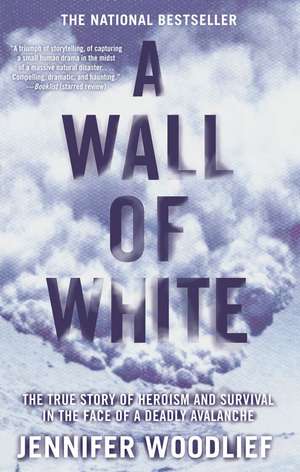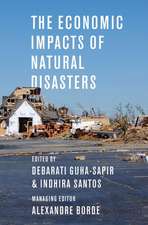A Wall of White: The True Story of Heroism and Survival in the Face of a Deadly Avalanche
Autor Jennifer Woodliefen Limba Engleză Paperback – 31 ian 2010
The unprecedented avalanche that day at Alpine Meadows was a once-in-a-lifetime catastrophe. Much like the nor'easter that bedeviled the fishermen in Sebastian Junger's The Perfect Storm, an unforeseeable confluence of natural events created the conditions for an unimaginable disaster -- and, in one woman's case, an astonishing ordeal of survival.
Jennifer Woodlief movingly tells the story of the massive slab avalanche that killed seven and left one victim buried alive under the snow. In this freak event, millions of tons of snow roared into the ski area and beyond, engulfing unsuspecting vacationers as well as resort employees working in spite of the danger.
At the center of this wrenching tale of nature's fury are ski patrolman Larry Heywood and his team, who heroically fought with the help of a search-and-rescue dog to save a twenty-two-year-old woman trapped for five days underneath the suffocating snow -- a tale of survival that is itself an exploration of the capacity of courage.
Written with all the suspense of a thriller, A Wall of White is an inspiring story of a group of strangers brought together by an inconceivable calamity -- a testament to the unwavering dedication of a band of rebel rescuers, driven only by a commitment to saving lives, battling not just extreme conditions but seemingly impossible odds.
Preț: 135.84 lei
Nou
Puncte Express: 204
Preț estimativ în valută:
25.100€ • 27.04$ • 21.46£
25.100€ • 27.04$ • 21.46£
Carte disponibilă
Livrare economică 24 martie-07 aprilie
Preluare comenzi: 021 569.72.76
Specificații
ISBN-13: 9781416546948
ISBN-10: 1416546944
Pagini: 243
Dimensiuni: 147 x 226 x 20 mm
Greutate: 0.32 kg
Editura: Atria Books
ISBN-10: 1416546944
Pagini: 243
Dimensiuni: 147 x 226 x 20 mm
Greutate: 0.32 kg
Editura: Atria Books
Recenzii
"Whenever you are faced by something that seems impossible to conquer, remember A Wall of White. It's a mesmerizing tale of human courage and heroism. Having been buried by an avalanche, I can confirm that this story will be unforgettable to readers -- adventurers and couch adventurers alike. Read it, be inspired, and keep on looking ahead!"-- Nando Parrado, bestselling author of Miracle in the Andes
"Fiercely compelling and at times heartbreaking, Jennifer Woodlief's A Wall of White builds with the power of an oncoming avalanche until the last, and final, redeeming moment. A powerhouse inside-look at mountain rescuers' lives, A Wall of White deserves to fit on bookshelves alongside Jon Krakauer's Into Thin Air and Sebastian Junger's A Perfect Storm. Required reading for adventure fans."-- Wayne Johnson, author of White Heat: The Extreme Skiing Life
"A mesmerizing tale of human courage and heroism."-- Nando Parrado, bestselling author of Miracle in the Andes
"Fiercely compelling and at times heartbreaking, Jennifer Woodlief's A Wall of White builds with the power of an oncoming avalanche until the last, and final, redeeming moment. A powerhouse inside-look at mountain rescuers' lives, A Wall of White deserves to fit on bookshelves alongside Jon Krakauer's Into Thin Air and Sebastian Junger's A Perfect Storm. Required reading for adventure fans."-- Wayne Johnson, author of White Heat: The Extreme Skiing Life
"A mesmerizing tale of human courage and heroism."-- Nando Parrado, bestselling author of Miracle in the Andes
Extras
One
The blizzard had hit the Sierra Nevada the previous Saturday evening, and it had been snowing steadily -- and hard -- for the past four days. With two to three feet of new snow falling daily, by that Wednesday morning the storm had dumped nearly seven and a half feet of new snow on top of an existing 89-inch base.
Most of the roads were impassable because snowplows were unable to keep ahead of the snowfall, and the tourists up for ski vacations were more or less trapped in their rental houses and condos. Larry's big old turquoise Jeep Wagoneer, nicknamed Gus because that's what the random letters in the license plate happened to spell, had made it, barely, from his home on Lake Tahoe's West Shore to Highway 89 and then down the three miles of Alpine Meadows Road that dead-ended at the ski area. Between the road conditions and the fury of the blizzard, Larry had been creeping along at maybe six mph. He spent much of the drive with his door open, craning around it to try to see where the road was and if anyone else was on it.
On his way to work Larry had picked up Thom Orsi, a member of the ski area's trail crew. Thom, who had spied crocus bulbs beginning to bloom in his yard the previous Saturday, trudged down to the street that morning on top of the snowdrifts in his driveway, with his car, unseen, buried somewhere beneath him. As they headed toward the ski resort, the drive was oppressive, almost claustrophobic. Maneuvering his Jeep in a virtual elevator shaft of snow, Larry asked Thom to keep an eye out for avalanche activity on the slopes above them. "You see anything moving," Larry told Thom, "you scream." Thom spent the remainder of the trip -- in the dark, in a near whiteout -- clearing off his foggy window and gaping up at the snow-drenched mountains.
Two days earlier, Alpine Meadows had closed the upper part of the ski area, and the previous day, it was running only the three lowest chairlifts for the benefit of a dozen or so skiers. The lifts high up on the mountain, leading to the advanced runs, were swaying too much in the shrieking winds to be operated -- ironically, skiers who were hard-core enough to ski despite the storm had access to just the shortest, easiest slopes.
On the thirty-first, the intense snowfall -- several new inches continued to fall every hour -- combined with winds gusting up to 120 mph, made it too risky for the resort to operate at all. The acres of existing snow up on the ridges above the ski area remained poised and still, piling higher and building up ton by ton with new snow. As fresh snow fell, the violence of the southwesterly wind whipped it across and down, cross-loading the mountain and transporting more snow to the lower slopes. On top of that, the freakishness of the fluctuating temperature over the past few days helped add up to one unstable snowpack. The virtually unprecedented mix of these particular elements resulted in the U.S. Forest Service snow ranger station, as well as Alpine Meadows' own avalanche forecaster, issuing a warning that the level of avalanche hazard on March 31 was "extreme."
Covering approximately 2,000 acres, Alpine Meadows is located in Bear Valley on the east side of the Sierra Nevada, along the Sierra Crest ridgeline, five miles north of Lake Tahoe, California. It shares its northern ridge with Squaw Valley, located one valley over. The terrain was originally heavily glaciated, which produced a series of enormous cirques separated by steep ridges. The resort's high floor -- almost 7,000 feet above sea level -- guarantees an immense amount of snow, and the ski runs range from tame to some of the country's most challenging, nearly all of which showcase a postcard view of shimmering Lake Tahoe.
Alpine Meadows was established on land leased from the Southern Pacific Land Company and the U.S. Forest Service. Soon after it opened, on December 28, 1961, the intensity of the snowfall and the steep terrain in the area caused the Forest Service to label Alpine Meadows as one of the few Class A avalanche areas in the country, the highest possible hazard designation. As a result, the resort developed one of the most proficient, experienced, and intense avalanche forecasting and control programs in the country.
Larry had been at Alpine Meadows working ski patrol on and off for the past dozen years. In 1982 the patrol was made up almost solely of men (a lone woman had signed on just a few seasons prior) and an incredibly macho bunch at that -- the type that couldn't wait to get to work in the morning and blow things up. In addition to saving lives, the main function of the Alpine Meadows ski patrol was to control avalanches, which meant throwing bombs and firing artillery into the slopes to set off small avalanches in an effort to prevent big ones. The guys on ski patrol were essentially made up of equal parts firefighter, cop, paramedic, explosives expert, mountain guide, and ski bum. Their reason for living was to make things safe, and although they took this role incredibly seriously, no one ever had more fun at their job.
The orientation alone seemed like it would have driven most prospective patrollers out of the snow for good, but on the contrary, the challenge only seemed to strengthen their resolve for the work. Larry's initiation to the danger of avalanches during his rookie season was a terrifying, sickening experience, sort of like a hazing prank gone wild. Norm Wilson, the mountain manager at the time, took Larry out to Peril Ridge to become accustomed to the feel of the snow, to learn how sometimes merely adjusting his weight at the wrong place on an unstable slope could set off an avalanche. Norm's plan was to teach Larry not merely about the potential threat of the snowpack, but also the hazards of overconfidence. Larry saw the snow in front of him hump up, and then, like a tablecloth yanked off a set table, he was knocked completely back off his feet. It wasn't a big enough slide to bury him, but it was a huge moment in his life, teaching him more in those few seconds about power and respect than he had ever learned before. The experience did not, however, deter him from wanting to be on ski patrol.
Despite Larry's passion for the work, by age 34 he figured it was just about time for him to move on and start building houses for a living. There were two men above him -- Bernie Kingery, the mountain manager, and Bob Blair, the patrol director -- who loved their jobs just as much as he did and weren't going anywhere.
Already a few feet of new snow had filled the parking lot since the previous day. There was almost no place to park, not because the lot was full of cars, but because there were massive piles of snow everywhere. One of the spots closest to the resort happened to be shoveled out, and Larry pulled in right next to the ski lodge.
As he and Thom got out of the Jeep, movement near the ground caught Larry's eye. Through the dawning light and swirling snow, he made out an owl -- definitely alive, but bouncing along the parking lot, tumbling with the wind and the blizzard. It was a small owl, maybe 8-10 inches tall, with yellow eyes and a white face outlined in brown and white. It had intricate off-white and light brown markings and no ears.
In all the time Larry had spent in the area, he had only seen an owl maybe once or twice before, at dusk, while camping deep in the forest. This particular type of owl, which he later realized was a Saw-whet owl, is secretive, strictly nocturnal, and almost never glimpsed by humans. Bird-watchers consider a sighting of this specific kind of owl to be a once-in-a-lifetime experience.
The mythology of owls throughout the world is connected to a general belief that the bird is an omen of evil, and that forest owls in particular are a portent of death. For many Native Americans (especially the Apaches and the Ojibwa) and the Aboriginal people of Australia, as well as several cultures in Africa, Asia, and South America, the perception of owls involves powerful taboos with deep roots. In West Africa, the pidgin English name for owl is "witchbird." In old Armenian tales, owls were associated with the devil, and in Russian folklore, owls, especially small ones, were believed to be harbingers of deaths and disasters. Even Shakespeare, in Macbeth, describes the owl as a messenger of death, calling it "the fatal bellman" -- a night watchman who rings a bell at the door of a prisoner scheduled for execution in the morning.
Larry followed the owl that morning, trying to help it, save it, but eventually the storm blew it underneath a parked bus, and he could no longer see it. He gathered up his gear and headed in to work.Copyright © 2009 Jennifer Woodlief
It was snowing as hard as it could possibly snow.It was around 5 a.m., just before daybreak, when Larry Heywood pulled into the Alpine Meadows parking lot on March 31, 1982. The multi-day snowstorm would finally force the ski area to shut down entirely that day, but open or not, as assistant patrol director at the resort, Larry was one of the few employees who still had to report to work.
--
Larry Heywood, assistant patrol director at Alpine Meadows in 1982
The blizzard had hit the Sierra Nevada the previous Saturday evening, and it had been snowing steadily -- and hard -- for the past four days. With two to three feet of new snow falling daily, by that Wednesday morning the storm had dumped nearly seven and a half feet of new snow on top of an existing 89-inch base.
Most of the roads were impassable because snowplows were unable to keep ahead of the snowfall, and the tourists up for ski vacations were more or less trapped in their rental houses and condos. Larry's big old turquoise Jeep Wagoneer, nicknamed Gus because that's what the random letters in the license plate happened to spell, had made it, barely, from his home on Lake Tahoe's West Shore to Highway 89 and then down the three miles of Alpine Meadows Road that dead-ended at the ski area. Between the road conditions and the fury of the blizzard, Larry had been creeping along at maybe six mph. He spent much of the drive with his door open, craning around it to try to see where the road was and if anyone else was on it.
On his way to work Larry had picked up Thom Orsi, a member of the ski area's trail crew. Thom, who had spied crocus bulbs beginning to bloom in his yard the previous Saturday, trudged down to the street that morning on top of the snowdrifts in his driveway, with his car, unseen, buried somewhere beneath him. As they headed toward the ski resort, the drive was oppressive, almost claustrophobic. Maneuvering his Jeep in a virtual elevator shaft of snow, Larry asked Thom to keep an eye out for avalanche activity on the slopes above them. "You see anything moving," Larry told Thom, "you scream." Thom spent the remainder of the trip -- in the dark, in a near whiteout -- clearing off his foggy window and gaping up at the snow-drenched mountains.
Two days earlier, Alpine Meadows had closed the upper part of the ski area, and the previous day, it was running only the three lowest chairlifts for the benefit of a dozen or so skiers. The lifts high up on the mountain, leading to the advanced runs, were swaying too much in the shrieking winds to be operated -- ironically, skiers who were hard-core enough to ski despite the storm had access to just the shortest, easiest slopes.
On the thirty-first, the intense snowfall -- several new inches continued to fall every hour -- combined with winds gusting up to 120 mph, made it too risky for the resort to operate at all. The acres of existing snow up on the ridges above the ski area remained poised and still, piling higher and building up ton by ton with new snow. As fresh snow fell, the violence of the southwesterly wind whipped it across and down, cross-loading the mountain and transporting more snow to the lower slopes. On top of that, the freakishness of the fluctuating temperature over the past few days helped add up to one unstable snowpack. The virtually unprecedented mix of these particular elements resulted in the U.S. Forest Service snow ranger station, as well as Alpine Meadows' own avalanche forecaster, issuing a warning that the level of avalanche hazard on March 31 was "extreme."
Covering approximately 2,000 acres, Alpine Meadows is located in Bear Valley on the east side of the Sierra Nevada, along the Sierra Crest ridgeline, five miles north of Lake Tahoe, California. It shares its northern ridge with Squaw Valley, located one valley over. The terrain was originally heavily glaciated, which produced a series of enormous cirques separated by steep ridges. The resort's high floor -- almost 7,000 feet above sea level -- guarantees an immense amount of snow, and the ski runs range from tame to some of the country's most challenging, nearly all of which showcase a postcard view of shimmering Lake Tahoe.
Alpine Meadows was established on land leased from the Southern Pacific Land Company and the U.S. Forest Service. Soon after it opened, on December 28, 1961, the intensity of the snowfall and the steep terrain in the area caused the Forest Service to label Alpine Meadows as one of the few Class A avalanche areas in the country, the highest possible hazard designation. As a result, the resort developed one of the most proficient, experienced, and intense avalanche forecasting and control programs in the country.
Larry had been at Alpine Meadows working ski patrol on and off for the past dozen years. In 1982 the patrol was made up almost solely of men (a lone woman had signed on just a few seasons prior) and an incredibly macho bunch at that -- the type that couldn't wait to get to work in the morning and blow things up. In addition to saving lives, the main function of the Alpine Meadows ski patrol was to control avalanches, which meant throwing bombs and firing artillery into the slopes to set off small avalanches in an effort to prevent big ones. The guys on ski patrol were essentially made up of equal parts firefighter, cop, paramedic, explosives expert, mountain guide, and ski bum. Their reason for living was to make things safe, and although they took this role incredibly seriously, no one ever had more fun at their job.
The orientation alone seemed like it would have driven most prospective patrollers out of the snow for good, but on the contrary, the challenge only seemed to strengthen their resolve for the work. Larry's initiation to the danger of avalanches during his rookie season was a terrifying, sickening experience, sort of like a hazing prank gone wild. Norm Wilson, the mountain manager at the time, took Larry out to Peril Ridge to become accustomed to the feel of the snow, to learn how sometimes merely adjusting his weight at the wrong place on an unstable slope could set off an avalanche. Norm's plan was to teach Larry not merely about the potential threat of the snowpack, but also the hazards of overconfidence. Larry saw the snow in front of him hump up, and then, like a tablecloth yanked off a set table, he was knocked completely back off his feet. It wasn't a big enough slide to bury him, but it was a huge moment in his life, teaching him more in those few seconds about power and respect than he had ever learned before. The experience did not, however, deter him from wanting to be on ski patrol.
Despite Larry's passion for the work, by age 34 he figured it was just about time for him to move on and start building houses for a living. There were two men above him -- Bernie Kingery, the mountain manager, and Bob Blair, the patrol director -- who loved their jobs just as much as he did and weren't going anywhere.
Already a few feet of new snow had filled the parking lot since the previous day. There was almost no place to park, not because the lot was full of cars, but because there were massive piles of snow everywhere. One of the spots closest to the resort happened to be shoveled out, and Larry pulled in right next to the ski lodge.
As he and Thom got out of the Jeep, movement near the ground caught Larry's eye. Through the dawning light and swirling snow, he made out an owl -- definitely alive, but bouncing along the parking lot, tumbling with the wind and the blizzard. It was a small owl, maybe 8-10 inches tall, with yellow eyes and a white face outlined in brown and white. It had intricate off-white and light brown markings and no ears.
In all the time Larry had spent in the area, he had only seen an owl maybe once or twice before, at dusk, while camping deep in the forest. This particular type of owl, which he later realized was a Saw-whet owl, is secretive, strictly nocturnal, and almost never glimpsed by humans. Bird-watchers consider a sighting of this specific kind of owl to be a once-in-a-lifetime experience.
The mythology of owls throughout the world is connected to a general belief that the bird is an omen of evil, and that forest owls in particular are a portent of death. For many Native Americans (especially the Apaches and the Ojibwa) and the Aboriginal people of Australia, as well as several cultures in Africa, Asia, and South America, the perception of owls involves powerful taboos with deep roots. In West Africa, the pidgin English name for owl is "witchbird." In old Armenian tales, owls were associated with the devil, and in Russian folklore, owls, especially small ones, were believed to be harbingers of deaths and disasters. Even Shakespeare, in Macbeth, describes the owl as a messenger of death, calling it "the fatal bellman" -- a night watchman who rings a bell at the door of a prisoner scheduled for execution in the morning.
Larry followed the owl that morning, trying to help it, save it, but eventually the storm blew it underneath a parked bus, and he could no longer see it. He gathered up his gear and headed in to work.Copyright © 2009 Jennifer Woodlief
Notă biografică
Jennifer Woodlief






